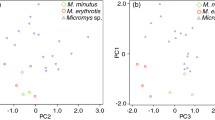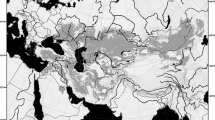Abstract
Zokor (Myospalacinae) is one of the subterranean rodents, endemic to east Asia. Due to the convergent and parallel evolution induced by its special lifestyles, the controversies in morphological classification of zokor appeared at the level of family and genus. To resolve these controversies about taxonomy and phylogeny, the phylogenetic relationships of 20 species of Muroidea and six species of zokors were studied based on complete mitochondrial genome and mitochondrial Cytb gene, respectively. Phylogeny analysis of 20 species of Muroidea indicated that the zokor belonged to the family Spalacidae, and it was closer to mole rat rather than bamboo rat. Besides, by investigating the phylogenetic relationships of six species of zokors, the status of two genera of Eospalax and Myospalax was affirmed because the two clades differentiated in phylogenetic tree represented two types of zokors, convex occiput type and flat occiput type, respectively. In addition, the two origins in Eospalax were found diverged at 3.71 million years ago (Ma) based on estimation of divergence time. It is suggested that the climate and ecology changes caused by the Qinghai-Tibet Plateau uplift event in 3.6 Ma led to the inner divergence of Eospalax. The intraspecific phylogenetic relationships of partial zokors were well resolved, the two clades of Eospalax cansus represented two geographical populations, respectively, and the divergent pattern of Eospalax baileyi was characterized by allopatric divergence spatially. In this study, we explored the taxonomic status and phylogenetic relationships of Myospalacinae at the molecular level. These works would be significant to understanding the evolutionary process and to clarify the mechanism of differentiation of Myospalacinae.




Similar content being viewed by others
References
Alexandros S. 2006 RAxML-VI-HPC: Maximum likelihood-based phylogenetic analyses with thousands of taxa and mixed models. Bioinformatics 22, 2688–2690.
Allen G. M. 1940 The mammals of China and Mongolia. Natural history of Central Asia. In The American museum of natural history, vol. 11, pp. 1−620. Natural History of Central Asia, New York.
Alston E. R. 1876 On the classification of the Order Glires. Proc. Zool. R. Soc. London, Ser. B. 44, 61–98.
Bouckaert R., Heled J., Denise Kühnert., Vaughan T. and Drummond A. J. 2014 BEAST 2: A Software platform for bayesian evolutionary analysis. PLoS Comput. Biol. 10, 1–8.
Carleton M. D. and Musser G. G. 1984 Muroid rodents. In Orders and families of recent mammals of the world (ed. S. Anderson and J. K. Jones), pp. 289−379. John Wiley, New York.
Corbet G. B. and Hill J. E. 1991 The mammals of the Indo-Malayan region: A systematic review. Oxford University Press, Oxford.
Darriba D., Taboada G. L., Doallo R. and Posada D. 2012 jModelTest 2: more models, new heuristics and parallel computing. Nat. Methods 9, 772.
Drummond A. J. and Rambaut A. 2007 BEAST: Bayesian evolutionary analysis by sampling trees. BMC Evol. Biol. 7, 210–214.
Ellerman J. R. and Morrison-Scott T. C. S. 1953 Checklist of Palaearctic and Indian Mammals—Amendments. J. Mammal. 34, 1−8.
Fan N. C. and Shi Y. Z. 1982 A revision of the zokors of subgenus Eospalax. Acta Theriolog. Sin. 2,183–199.
Flynn and Lawrence J. 2009 Chapter 4. The antiquity of rhizomys and independent acquisition of fossorial traits in subterranean muroids. Bull. Am. Museum Nat. Hist. 331, 128−156.
Jansa S. A. and Weksler M. 2004 Phylogeny of muroid rodents: relationships within and among major lineages as determined by IRBP gene sequences. Mol. Phylogenet. Evol. 31, 256−276.
Jansa S. A., Giarla T. C. and Lim B. K. 2009 The phylogenetic position of the rodent genus Typhlomys and the geographic origin of Muroidea. J. Mammal.. 90, 1083–1094.
Jeanmougin F., Thompson J. D., Gouy M., Higgins D. G. and Gibson T. J. 1998 Multiple sequence alignment with Clustal X. Trends Biochem. Sci. 23, 403–405.
Kimura M. 1980 A simple method for estimating evolutionary rate of base substitutions through comparative studies of nucleotide sequences. J. Mol. Evol. 16,111−120.
Lacey E. A., Patton J. L. and Cameron G. N. 2001 Life underground: the biology of subterranean rodents. Aust. Mammal.. 23, 75−76.
Lanfear R., Frandsen P. B., Wright A. M., Senfeld T. and Calcott B. 2017 PartitionFinder 2: new methods for selecting partitioned models of evolution for molecular and morphological phylogenetic analyses. Mol. Biol. Evol. 34, 772–773.
Lawrence M. A. 1991 A fossil Myospalax occiput (Rodentia: Muridae) from Shanxi, China, with observations on zokor relationships. Bull. Am. Museum Nat. Hist. 206, 261–286.
Li J. J. and Fang X. M. 1998 Study on uplift and environmental change of Qinghai-Tibet Plateau. Chin. Sci. Bull. 43, 1569−1574.
Li X. C. and Wang T. Z. 1996 The classification and phylogeny of the genus Eospalax. J. Shaanxi Normal Uni. (Nat. Sci. Edi.) 3, 75–78.
Lin G. H., Wang K., Deng X. G., Nevo E., Zhao F., Su J. P. et al. 2014 Transcriptome sequencing and phylogenomic resolution within Spalacidae (Rodentia). BMC Genomics 15, 32−32.
Luo Z. X., Chen W., Gao W., Wang Y. X. and Li C.Y. 2000 Fauna sinica: mammalia, vol. 6. Rodentia, part III: Cricetidae. Science Press, Beijing.
Marshall E. 2005 Will DNA bar codes breathe life into classification? Science 307, 1037–1037.
McKenna M. C. and Bell S. K. 1997 Classification of mammals: above the species level, pp. 1−631. Columbia University Press, New York.
Miller G. S. and Gidley J. W. 1918 Synopsis of the supergeneric groups of rodents. J. Wash. Acad. Sci. 8, 431–448.
Nguyen L. T., Schmidt H. A., Haeseler A. V. and Minh B. Q. 2015 IQ-TREE: A fast and effective stochastic algorithm for estimating maximum likelihood phylogenies. Mol. Biol. Evol. 32, 268−274.
Norris R. W., Zhou K. Y., Zhou C. Q., Yang G., William K. C. and Honeycutt R. L. 2004 The phylogenetic position of the zokors (Myospalacinae) and comments on the families of muroids (Rodentia). Mol. Phylogenet. Evol. 31, 972–978.
Pavlinov I. A. 2003 Systematics of recent mammals, pp. 85–92. Moscow University, Moscow,
Pavlinov I. A. and Lissovsky A. A. 2012 The mammals of Russia: a taxonomic and geographic reference, pp. 202−210. KMK Scientific, Moscow.
Perdiguero E. G., Klapproth K., Schulz C., Busch K., Azzoni E., Crozet L. et al. 2015 Tissue-resident macrophages originate from yolk-sac-derived erythro-myeloid progenitors. Nature 518, 547−551.
Ronquist F. and Huelsenbeck J. P. 2003 MrBayes 3: Bayesian phylogenetic inference under mixed models. Bioinformatics 19, 1572–1574.
Smith A. T. and Xie Y. 2009 Chinese wildlife manual, pp. 88−92. Hunan Education Press, Changsha.
Song S. Y. 1986 A revision of the two species of the zokors on subgenus Eospalax. La Ani. Mondo 3, 31–39.
Su J. H., Wang J., Liu R. T., Hua L. M., Wu J. P. and Liu F. Y. 2011 Species validities of zokors (Mysopalacinae) inferred from mt DNA sequences variations. Acta Agrestia Sin. 19, 694−698.
Su J., Ji W., Wang J., Gleeson D. M., Zhou J. W., Hua L. M. et al. 2013 Phylogenetic relationships of extant zokors (Myospalacinae) (Rodentia, Spalacidae) inferred from mitochondrial DNA sequences. Mitochondr. DNA 25, 135–141.
Tang L., Wang L., Cai Z., Zhang T. Z., Ci H. X., Lin G. H. et al. 2010 Allopatric divergence and phylogeographic structure of the plateau zokor (Eospalax baileyi), a fossorial rodent endemic to the Qinghai-Tibetan Plateau. J. Biogeogr. 37, 657−668.
Thomas O. 1896 On the genera of rodents: an attempt to bring up to date the current arrangement of the order. Proc. Zool. Soc. Lond. 64, 1012–1028.
Tullberg T. 1899 Ueber das System der Nagethiere: eine phylogenetische Studie, pp. 1–514. Akademische Buchdruckerei, Uppsala.
Wang T. Z. 1993 Rodent Fauna of Shaanxi. Shaanxi Normal University Press, Xian.
Wang Y. X. 2003 Taxonomic directory and distribution of mammal species and subspecies in China. China Forestry Publishing House, Beijing.
Wilson D. E. and Reeder D. M. 2005 Mammal species of the world: a taxonomic and geographic reference. vol. 1, JHU Press, Baltimore.
Yang H. S, He X. Q., Liu R. T., Zhang S. L. and Chang G. Z. 2009 The study of phylogeny of Eospalax in Gansu. Acta Pratacul. Sin. 18, 204−209.
Zhao F., Deng X. G., Zhang T. Z., Su J. P. and Lin G. H. 2015 Molecular authentication of Sailonggu and its resource distribution in Qinghai-Tibet Plateau. Chin. J. Tradition. Med. 40, 399.
Zheng S. H. 1994 Classification and evolution of the Siphneidae In Rodent and lagomorph families of Asian origins and diversification (ed. Y. Tomida Y., C. K. Li and T. Setoguchi), pp. 57–76. National Science Museum Monographs, Tokyo.
Zheng S. H. 1997 Evolution of the Mesosiphneinae (Siphneidae, Rodentia) and environmental change. In Evidence for Evolution-Essays in Honor of Prof. Chungchien Young on the Hundredth Anniversary of His Birth (ed. Y. S. Tong, Y. Y. Zhang, W. Y. Wu, L. J. Li and L. Q. Shi), pp 137–150. China Ocean Press, Beijing.
Zhou C. Q. and Zhou K. Y. 2008 The validity of different zokor species and the genus Eospalax inferred from mitochondrial gene sequences. Integr. Zool 3, 290−298.
Zhou C. Q., Zhou K. Y. and Zhang S. 2004 Molecular Authentication of the Animal Crude Drug Sailonggu (Bone of Myospalax baileyi). Biol. Pharm. Bull. 27, 1850–1858.
Acknowledgments
We sincerely thank Forest Disease and Pest Control Quarantine Station of Ningxia Hui Autonomous Region for collecting samples of Gansu zokor. This work was supported by the National Key Programme of Research and Development (2017YFD0600103-4-1) and National Promoted Programme of scientific and technological achievements in Forestry and Grassland (201929), and the Key Laboratory of Forestry and Grassland Administration in China on Management of Western Forest Bio-Disaster, Northwest Agriculture and Forestry University, Yangling.
Author information
Authors and Affiliations
Corresponding authors
Additional information
Corresponding editor: H. A. Ranganath
Rights and permissions
About this article
Cite this article
Zou, Y., Xu, M., Ren, S. et al. Taxonomy and phylogenetic relationship of zokors. J Genet 99, 38 (2020). https://doi.org/10.1007/s12041-020-01200-2
Received:
Revised:
Accepted:
Published:
DOI: https://doi.org/10.1007/s12041-020-01200-2




